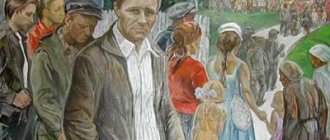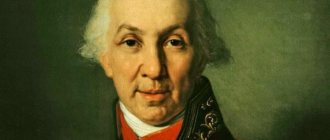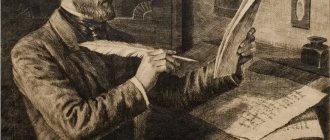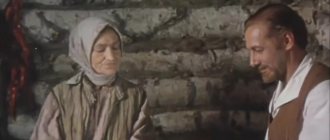The writer M.E. Saltykov-Shchedrin grew up surrounded by landowner families, endowed with vices and lies, which weighed heavily on him. A deep knowledge of this environment was later reflected in the work of Mikhail Evgrafovich, including in his novel “The Golovlev Gentlemen.” Analysis of the work, which is taught in the 10th grade of the school curriculum, allows us to analyze its key points in more detail.
Novel genre
The book shows the process of self-destruction using the example of a noble family, and reliably characterizes the real essence of this layer of society. “The Golovlevs” is a work that depicts a chronicle of events, a chronicle of the extinction of a family. Initially, the writer conceived of documentary socio-psychological essays, which were then combined into a novel. It fully reveals the psychology of the characters through their actions, and not through the internal monologues of the characters. The influence of social reasons on the level of psychological development of the individual is also shown.
In terms of its genre, “The Golovlev Gentlemen” is a novel of the social and everyday genre with a detailed description of relationships in landowner families. M. E. Saltykov-Shchedrin is a realist writer who used satire techniques (grotesque, in particular) in his work, focusing on the inferiority and shortcomings of the described phenomena without distorting proportions.
The history of the creation of “Lord Golovlev” began in 1875. First, the first chapter was published, which Turgenev himself highly appreciated. He personally advised Saltykov-Shchedrin to continue publishing his works. Subsequently, all other chapters appeared.
Brief Analysis
Year of writing – 1875-1880.
History of creation - Initially, M. E. Saltykov-Shchedrin wanted to write a cycle of stories “Well-Intentioned Speeches.” He even published several small works in the journal Otechestvennye zapiski. Gradually, the writer became so inspired by the work, he combined the stories, turning the cycle into a novel.
Theme – The main theme of the work is the life of landowners on the eve of the abolition of serfdom and after this event. In the context of it, the motive of spiritual and physical destruction of a person develops.
Composition - The novel is organized in such a way that all its elements, plot and non-plot, serve to reveal the theme and convey the idea. The work begins with a plot (the trial of Stepan), followed by exposition and other plot elements in a logical sequence.
Genre – Socio-psychological novel.
Direction – Realism.
Topics covered in the book
The main theme of the novel is the gradual decline, degeneration, gradual decline of the noble family, and the collapse of family ties in general. The key idea of the work is the reasons for such degeneration: an idle lifestyle, inactivity, idle talk, lack of love between loved ones, lack of spirituality.
The novel is characterized by the interweaving of moral and ethical problems with social problems. The issue of the collapse of the “noble nest” was the most important at that time, but for the first time it was shown so satirically, without any regrets or sympathy. The Golovlev family is dying not from poverty, but from the spiritual degradation of its members. The author in his work examines problems leading to complete degeneration:
- First of all, this is a hereditary character, the repetition of vices and negative traits in children and grandchildren - Judas is depicted as even more hypocritical than his mother, and his brothers are shown as more weak-willed than their father.
- Secondly, the very lifestyle of family members, where idleness, lack of any mental or physical activity, drunkenness, lack of communication, and monotonous nutrition prevail.
- The passion for hoarding, characteristic of Arina Golovleva, which became another reason for the degeneration of the family, because it only turned into trouble for her children.
Composition of M. E. Saltykov-Shchedrin’s novel “Gentlemen Golovlevs”
The topic of serfdom in Russia has always been the subject of close attention of the great writer Saltykov-Shchedrin.
At the end of the 70s, the writer approached in his work a solution to a topic that he could take on only after accumulating the necessary vital material, possessing vast ideological experience, and standing on firm revolutionary-democratic positions. The hero of the work he conceived was supposed to personify all the vices and ills of feudal society. This is a man “filled with the ashes” of self-destruction. The author has already addressed this topic in the satirical chronicle “Well-Intentioned Speeches,” but it received deeper development in the novel “Lord of the Heads of the Left.” The story of the death of the Golovlev family of serf owners was initially part of the chronicle “Well-Intentioned Speeches,” which was mainly devoted to describing the reality of the predatory bourgeois Derunov. The writer decided to highlight stories about the Golovlev family from the chronicle and created on their basis the novel-chronicle “The Golovlev Gentlemen.” Its composition was subordinated to one theme - the collapse of serfdom. The novel begins with a premonition of the death of one of the heroes (Stepan), then throughout the narrative we are presented with a whole gallery of dying people leaving the scene of life. “The Golovlevs are death itself, evil, empty; this is death, always lying in wait for a new victim,” the satirist wrote. The images of the Golovlevs of the older and younger generations are a vivid illustration of the detrimental impact on the human personality of an imperfect social system based on oppression. That is why the author in the novel pays attention to the more moral side of the matter, and not to the economic impoverishment of the serf owners. I would like to note that the author managed to portray specific characters so talentedly that they embodied all the vices of not only one family, but also the entire society. Judushka Golovlev is clearly depicted. The writer made him literally a symbol of all parasitism, misanthropy and reaction. All components of the novel: landscape, speech of the characters, author's characteristics and digressions - everything in the novel serves one purpose - to reveal the reasons for the death of the serf-owner system. Particularly striking is the speech of Judas - a misanthropist and fornicator, woven from aphorisms, diminutives and endearing words, sighs, hypocritical appeals to God, and continuous repetitions. I would also like to note another very important compositional point in the novel: the author deliberately excluded the details of serf life, the education of a new generation of serf-owners and their relationship with the peasants. It seems to me that the writer did this in order to create an even more hopeless background, out of harmony with the living world, against which the serf-owners become obsolete. Living, bright reality itself does not seem to let them out of the limited space, like a terrible contagious disease. The spirit of the author himself, who with all his soul loved the oppressed people of Russia and fought for their freedom, is also present and felt by the reader in the novel.
Storyline, composition
The fact that the novel was assembled from independent essays-chapters, each of which the author ends with the death of a family member or some story leading ultimately to it, left its mark on the composition. The first essay, “Family Court,” ends with the death of the eldest of Stepan’s sons, who squandered part of his inheritance and returned. He dies of consumption in the outbuilding, locked by his mother, and in his father’s old and worn robe. At the family court, it was decided (on the advice of Judas) not to send Stepan to his father’s village, so that he would not have the opportunity to lose this property.
The chapter “In a related way” describes the phenomena that played out 10 years after the abolition of serfdom. The mother transfers one of the villages (Dubrovino) to her youngest, leaving Golovlevka - the most tasty morsel, Porfiria. He subsequently drives mother away.
Pavel becomes an alcoholic and finds his death on the estate, not even having time to leave a will. The house goes to Judas. A poor mother with her twin granddaughters has to settle in Pogorelka, in poverty and squalor. The title of the chapter hides sarcasm and mockery, the fact of an invitation to settle “like relatives” in such miserable conditions after Judushka’s betrayal of his mother.
The next essay, “Family Results,” continues the series of deaths in the family, where Judushka’s eldest son, Vladimir, shot himself. He does this out of lack of money, hopelessness - due to deprivation of support due to marriage against the will of his father. And the youngest son Peter loses government money at cards . He does not receive any help from his father, and therefore he is sent to hard labor, where he dies. Such callousness of Porfiry forces his mother to finally break with him.
The history of the novel's birth
The history of Saltykov-Shchedrin’s novel, which belongs to highly social literature and touches on the problems of the nobility of that time, begins in 1875 with the writing of the essay “Family Court,” which was later included in the novel as its first chapter. The following essays, which were later combined into one novel, were published in the same year, and in 1876 Saltykov-Shchedrin decided to combine them into one novel. The finalization of the novel took a long time; two more essays were added. The novel “The Golovlevs,” which includes eight essays, was published as a separate edition in 1880.
This work by Saltykov-Shchedrin is autobiographical. The features of the writer's relatives can be traced in the features of the main characters. Thus, the mother of the family, Arina Golovleva, with her imperiousness and penchant for hoarding, resembles the mother of the writer himself, and her two children were copied from the brothers of Saltykov-Shchedrin himself.
Other chapters
The chapters of the work can be viewed in the form of a table, where opposite each of them you can write down the main events and thoughts that the author would like to convey. The part called “Niece” is overshadowed by the death of Arina Petrovna Golovleva herself. Pogorelka is eventually claimed by her granddaughters Anninka and Lyubinka, who left with the dream of becoming actresses. When Anninka arrives to formalize her inheritance, she has to face the harassment of her uncle, which is why she promises not to return here again.
Although the chapter “Illegal Family Joys” does not confront the reader with death, Arina Petrovna’s son Judushka actually condemns his illegitimate son Volodenka, whom his housekeeper gave birth to, to a miserable existence and death. Porfiry only cares about the amount to send the child to an orphanage.
The chapter “Escapee” describes how Judas begins to lose her human appearance. Because of what he did to their child, the housekeeper Evprakseyushka stops caring for her master and goes out with the coachman and the clerk. If we take a brief overview of this episode, the conclusion suggests itself that the wrong attitude to life leads to the moral decay of the heroes. Porfiry Golovlev in this chapter:
- begins to live in a world of fantasies and dreams;
- dreams of imaginary wealth;
- wants to take revenge on everyone.
The chapter “Reckoning” tells about two deaths at once: Lyubinka’s granddaughter and Porfiry himself. An ill Anninka arrives in Golovlevo. She shares the sad story of how Lyubinka got involved with the zemstvo employee Lyulkin, who stole money and shot himself out of despair. She also tells how she herself contacted his accomplice of merchant origin, exiled to Siberia. The poor sisters ended up trying to poison themselves from grief; Lyubinka managed to accomplish her plan, but Anninka couldn’t.
At the very end of the novel, Porfiry’s spiritual transformation takes place: Annushka, who drinks out of melancholy and grief, makes him feel guilty, he even tries to ask her for forgiveness, and then, wearing only a robe, he goes to his mother’s grave. He fails to get there because he freezes along the way. Anninka is also waiting for her death, but still retains the desire to seize the estate.
Main characters
Arina Petrovna at the beginning of the novel is described as a powerful woman of 60 years old, gifted with a creative imagination and in fact managing the estate. She doesn't like her neighbors and keeps her children obedient. This is an unyielding and obstinate person. No one in the family dares to go against Mrs. Golovleva. She is characterized by seriousness and efficiency; it seems that she cares about family members, but at the same time she remains indifferent to her husband and children. Children seem to Golovleva to be just a “hateful” burden. The woman believes that they can be raised from hand to mouth and without love.
Her husband, Vladimir Mikhailovich, a slacker, is characterized in the novel as “frivolous,” “drunk,” and “a writer of free poetry.” He called his wife “witch”, “devil”, and was afraid of her. Drunkenness and dissipation turned the father of the family into a decrepit old man.
Their eldest son Stepan (Styopka the mischievous, Styopka the dunce), his father’s favorite and an equally prankster, grows weak-willed and submissive due to constant humiliation from his mother. Although he studied at the university, the guy himself could not get a job. His mother bought him a house, but he squandered everything, did not succeed in the service, returned home and found his death in poverty.
Mother sent her daughter Annushka to college with the intention of making her an accountant. But the girl fell in love with a young cornet, whom she married without her parents' permission. After 2 years, the husband ran away, spending 5 thousand allocated by his mother. Annushka herself died, leaving behind twin girls (Anninka and Lyubinka).
Son Porfiry, who was nicknamed Judas, “frank boy”, “blood drinker”, loved to cuddle with his mother, did not hide anything from her, but she did not know whether it was poison or respect, and therefore was afraid of him. The author embodied in him a completely new type of monstrous and hypocritical traitor who repented in the end, like the biblical Judas. The youngest son, Pavel:
- was not interested in games or studies;
- did not like to communicate;
- was afraid of his mother.
Characters
The plot of the novel reflects the life of three generations. List and brief overview of the main characters of the older generation of the family:
- Arina Petrovna is a landowner, owner of a large estate. This is a powerful, unyielding woman, devoid of family feelings and accustomed to acting independently. She meets no opposition from anyone. Mrs. Golovleva manages the estate well and contributes to its prosperity. She believes that she does everything for the sake of the children. She owns the aphorism: “And for whom am I saving all this abyss? Who am I saving for? I don’t get enough sleep at night, I don’t get enough to eat… for whom?!”
- Her husband, Vladimir Mikhailovich, is a careless person, prone to idleness. He has long retired from managing the estate, lives idlely, writes free-form poetry, secretly drinks alcohol and watches for courtyard girls. He calls his wife a devil and a witch.
Children and grandchildren, for whom, according to Arina Petrovna, she tries, although in fact they are alien to her and are only a burden.
These are the following characters:
- Stepan, the eldest son, known as Stepka the mischievous and Stepka the dunce. This is a capable person who learned from his mother the ability to recognize people and guess their weaknesses, and from his father - prankishness. As a child, he used his talents to imitate people and play buffoonery, for which his mother often punished him.
- Daughter Anna. In her youth, her mother sent her to college, hoping to become a household accountant and secretary. But one night Annushka secretly ran away and got married to the cornet. Her mother gave her a “piece” in the form of a run-down village and capital, but the young people quickly spent the money, after which the cornet ran away. Annushka was left with two young twin children, Anninka and Lyubinka. Soon she died, and her mother took in the orphans. However, all these events contributed to the prosperity of the Golovlev estate, rounding it up and reducing the number of shareholders.
- Porfiry is the middle son, who received from Styopka the nicknames Judushka, Krovopivushka and “frank boy” (this is a quote from the novel). Since childhood, he was unusually affectionate and respectful with his mother, and loved to talk a little bit. But the insightful Arina Petrovna did not trust him and was a little afraid in her heart.
- Youngest son Pavel. In accordance with the author’s description, the person is gloomy and apathetic, having not committed any more or less significant actions in his life. Maybe he was kind, but he didn’t do anything good to anyone, he wasn’t stupid, but he didn’t do anything smart.
- Anninka and Lyubinka are the children of Anna Vladimirovna. We were raised by our grandmother and, as adults, became actresses.
- Vladimir and Peter are the children of Judushka Golovlev.
- Evprakseyushka is the housekeeper, Volodka’s mother.
Artistic originality of the work
Saltykov-Shchedrin in “The Golovlev Gentlemen” shows the complete hopelessness and extinction of the race throughout the entire narrative. He managed to embody this in specific actions, phrases and the appearance of his heroes. Their words do not call for any action, the beauty and youth of the characters are fleeting, their estates are ruined.
The wonderful names of the characters themselves seem to provoke no less monstrous acts, and their diminutive form is nothing more than caustic sarcasm. Much attention is paid to the fact of the characters’ godlessness, biblical parables and images. The author ends the novel with the death of Judas, imitating the biblical death and repentance of Judas.
This is the description of the work briefly. The issues raised in the book are indeed relevant. Perhaps this is why it is often considered in educational institutions today. Schoolchildren and students write reviews and essays in which they describe the topic of conflict between fathers and children. Critics are also interested in this work, and therefore they create reviews and reviews of it.
It may seem that the idea of the work is quite gloomy. Some readers even have questions about what message the author wanted to convey to his audience. But at the same time, the meaning of this book is somewhat ironic, because its characters do not correspond to their shell at all. It seems to many that landowners are noble people and lead a corresponding lifestyle. The story does a good job of revealing what is actually hidden inside.
Analysis of Saltykov-Shchedrin’s novel “The Golovlev Gentlemen”
The story of the Golovlevs is an artistic analysis of the reasons for the disintegration of family ties and the extinction of a family drowning in lack of spirituality, idle talk, and idle thinking. Milestones along this path are the fates of Arina Petrovna and her son Stepan Vladimirovich (Stepka the dunce) Golovlevs. A complex and rich nature is the first to be ruined by a way of life, the dominant of which is tradition, which has lost living connections with reality and has turned even maternal feelings into acting. Styopka the dunce's lifestyle becomes idle and unsuitable for practical activities.
Saltykov-Shchedrin’s novel “The Golovlevs” is devoid of the traditional Russian literature poeticization of a noble estate. Researchers find a psychological explanation for this in Saltykov’s everyday impressions of his own family, relations with which, according to the recollections of contemporaries and the writer himself, were characterized by brutal cruelty and were alien to any kindred warmth. Relationships in the writer’s family are reflected in his autobiographical book “Poshekhon Antiquity.” In “The Golovlev Gentlemen”, the prototypes for the characters in the work were members of the Saltykov family: mother Olga Mikhailovna Saltykova - Arina Petrovna Golovleva; brother Nikolai Evgrafovich - Styopka the dunce. When creating the image of Judas, Shchedrin relied on the characteristic features of his other brother, Dmitry Evgrafovich.
The artistic discovery of the novel is the image of Porfiry Vladimirovich Golovlev (Judushka) - a new psychological type in literature. He is characterized by hypocrisy, betrayal, and cruelty, which made the image a key word in the rich social and moral typology of the satirist.
Cyclization (of essays, chronicles, reviews) is a fundamental aspect of Shchedrin’s creative style. Its basis is, as a rule, a sequence related to the strategic plan of the author. This feature should also be taken into account when characterizing the genre of “The Golovlev Gentlemen”, in relation to which the term “novel” is used with the proviso that this work grew out of a cycle of essays.
Another feature of Saltykov-Shchedrin’s work is his commitment to satire. The most important technique of this type of literature is the grotesque, which has many varieties in the history of culture (the works of D. Swift, E.T.A. Hoffman, N.V. Gogol, etc.) Shchedrin’s creative style is distinguished by the fact that he does not distort the natural proportions of the subject under consideration phenomenon, but detects and accentuates its abnormal, affected areas and explores the prospect of their influence on the body as a whole. Shchedrin's creative system developed during the era of reforms in Russia in the second half of the 19th century.







